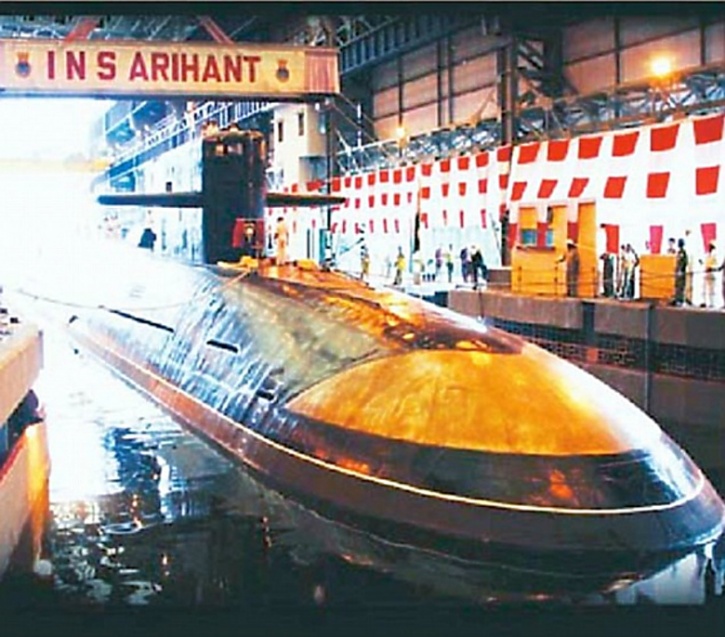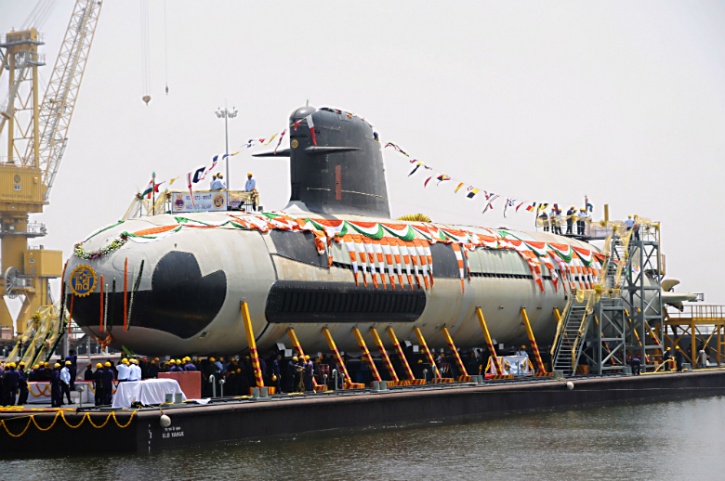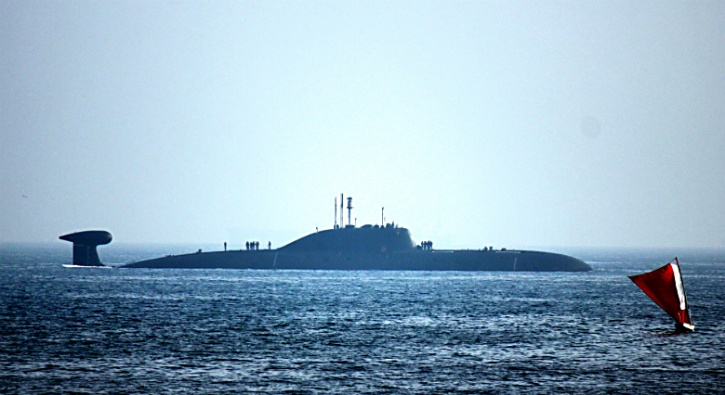Russian started, Indian financially upgraded INS Chakra (Akula 2 based) - along with INS Arihant (nuclear propelled testbed) perhaps more an Indian-French design - form the beginnings of India's SSN project.
---
Thanks to ZuluEcho at
Comment Thread (May 22, 2015) for drawing my attention to
Sandeep Unnithan's
India Today article of March 26, 2015. The article mainly deals with India's project to indigenously build 6 SSNs. The project has no name - so far? If the SSNs are built after the 4th Arihant class submarine is launched we may be talking 2025 for first launch of an SSN. The following are excerpts with my comments in [...] brackets and added links in [...] brackets.
Ar
ticle string is http://indiatoday.intoday.in/story/india-china-relations-modi-government-indian-ocean-naval-expansion/1/425929.html :
The Indian
Ocean riposte
The Modi government signals a new push into the
Indian Ocean with a diplomatic offensive and naval expansion to counter China's
growing presence
On February 18, 2015 the Cabinet Committee on Security (CCS)
formally cleared India's single-largest defence project: a joint Defence
Research and Development Organisation (DRDO)-Bhabha Atomic Research Centre
(BARC)-Navy project to build six nuclear-powered attack submarines or SSNs for
[very low price of] roughly [US] $12 billion (Rs 74,400 crore). This mammoth
'Make in India' project, nearly the size of the budget allotted this year to
the three services to buy hardware ($15 billion), was not an isolated policy
decision.
A senior naval official says India's ramped-up Indian Ocean push is a direct response to the expansion in China's naval capabilities including submarine deployments in the Indian Ocean over the past year, and oceanographic surveys meant to legitimise its presence in the region.
India's response is part of a recognition of not just its maritime capabilities, a comprehensive linkage between diplomacy and power projection capability and the fact that China's game plan has huge security implications. "We look at capabilities, not intentions. Intentions can change overnight. If the Chinese have the capability to base their ships in the Indian Ocean Region, it has huge security implications for us," the senior naval officer adds.
Late last year, the government dusted out a 2008 naval proposal for six SSNs...the six SSNs that will form the lynchpin of India's response to the Chinese navy.
The Indian Navy envisages multiple roles for a future nuclear-powered attack submarine fleet: two SSNs each to escort each of the three Carrier Battle Groups, protect the "bastion areas", or bases of the Arihant-class SSBNs, and hunt enemy submarines in the Indian Ocean Region. In the event of a Chinese offensive in the Himalayas, the SSNs will form the backbone of a future Indian riposte. They will run interdiction missions at vital choke points and conduct operations in enemy waters.
All of these tasks are presently carried out by a solitary [
INS Chakra], which is to be supplemented by a second SSN, possibly the [
Kashalot] to be leased from Russia for $2.7 billion in 2018. "SSN's utility in denial operations, raising the cost of hostile military intervention and shadowing high-value units such as carrier groups and SSBNs, is unparalleled," says Shankar.
The SSN project comes at a time when India's three-decade-old nuclear submarine project is finally coming up to speed. The [
INS Arihant] or the S2, the first of a class of four 6,000-tonne ballistic missile submarines, recently began her sea trials in Visakhapatnam. [My calculations are the 2nd [
INS Aridhaman], 3rd and 4th subs of the Arihant class will weigh around 8,000+ tons surfaced in order to accommodate the 8
K-4 missiles planned. Arihant itself is a testbed highly unlikely (too light and with too shallow a draught of 11m) to be commissioned with the 12m long-high K-4s.].
The submarine's performance in surface trials has enthused naval officials to plan for its commissioning in December this year. The INS Arihant cost around Rs 6,000 crore to build and can carry either 12 short-range [
K-15 missiles] or four K-4 nuclear tipped ballistic missiles with a range of 3,500 km. The DRDO has set up an SSN cell headed by a retired vice admiral in its nuclear submarine building hub, the [
Ship Building Centre (SBC) in Visakhapatnam]. The [
Navy's Delhi based Submarine Design Group] is now working to complete a design for these undersea vessels in the next two years. The shipyard to build the vessels is yet to be decided but officials say this programme will run parallel to the seven strategic submarines of the Advanced Technology Vessel Project (ATV).
THE TECHNOLOGICAL CHALLENGE
At roughly Rs 12,000 crore a unit, one SSN would equal the cost of two 7,500-tonne Project 15A Kolkata-class destroyers. Cost, however, has never been a hurdle. The belief in the need for a nuclear navy has led a series of PMs from Indira Gandhi to Narendra Modi to ensure generous budgetary support.
The ATV programme has spent over Rs 30,000 crore, most of it in secret funds which do not form part of the defence budget. Politicians have occasionally questioned if they were getting value for money. In 2005, then finance minister P. Chidambaram, a member of the apex political committee steering the classified project, wondered why the Arihant, costing over a billion dollars (Rs 6,200 crore), [was to carry only 4 K-4 missiles]. The project team doubled the missile load on three subsequent vessels [to 8
K-4 missiles for the 2nd [
INS Aridhaman], 3rd and 4th subs of the Arihant class]. The only challenges in the project have been technological. The CCS approval marks the start of a new challenge for scientists and nuclear engineers.
India's ATV project started as a troika of agencies. Steered by the DRDO which also developed the vessel's long-range ballistic missiles, it was staffed by naval project teams that brought in design expertise and BARC that built and developed the reactor. By the late 1990s, it had spent over Rs 2,000 crore on its classified ATV programme without results. The failure to produce a submarine had in 1998 piqued then navy chief Admiral Vishnu Bhagwat to call for a technical audit. Considerable Russian design assistance that followed the May 1998 nuclear tests breathed new life into the project. Even so, it took the Arihant 15 years from the start of construction to begin sea trials. The navy fought a pitched but unsuccessful battle to wrest the project away from DRDO control five years back.
A former DRDO chief is optimistic about the next line of submarines. "We are on schedule with the SSNs and we have the capability to design the submarine and build the reactor," he says.
The six SSNs will be a spin-off from a project that is building four Arihant class SSBNs or ballistic missile-firing nuclear submarines. The downstream effect of this Make in India project will be tremendous. One private sector official says the $12-billion project will have a force multiplier effect of $40 billion on the Indian economy, generating over a million skilled jobs and sustaining the ecosystem that has grown around the ATV project.
One admiral points out that while the SSN will be Arihant's size, designing and building it will be far more challenging as both platforms have different tasks. An SSBN like the Arihant is a stealth underwater bomber ready to launch nuclear-tipped missiles at an adversary. Its reactor needs to deliver steady speeds as it prowls undetected.
An SSN, on the other hand, is like a fighter jet. It needs a high-performance nuclear reactor which delivers tremendous speed with rapid acceleration and deceleration. It needs a reactor that can perform multiple tasks such as pursuing enemy warships and striking land targets. Opinion seems to be divided regarding the type of reactor that will power the SSN.
BARC wants the Arihant's 83 MW reactor to lead the way. "It's better to build on a proven design. The SSN should have a compact version of the same reactor," says Anil Anand, former head of the BARC reactor design team. A former admiral, also part of the project, differs and calls for a new 190 MW reactor such as the one on the Chakra to be designed.
The new SSN programme, experts say, is an opportunity to learn from past mistakes. Admiral Arun Kumar Singh, former eastern naval commander, calls for stringent supervision to ensure the project stays the course. "The Prime Minister must monitor its progress every year and the defence minister every three months. Otherwise what happens is that the DRDO gives us ambitious projections which it fails to meet," he says. Clearly, old ghosts will continue to haunt the project.
Also Read : India's string of flowers" ENDS
--------------------------------------------------------------------------
Please Connect with Submarine Matters articles:
-
Indian Possible Interest in Buying-Building Japan’s Soryu Submarine – Australia, January 30, 2015
- South Asian Submarine Issues, December 7, 2014, concerning construction of India's emerging SSBN base at INS
Varsha on the East coast below Visakhapatnam.
- India’s Plans for 21 More Subs including SSNs, August 24, 2014
Pete













